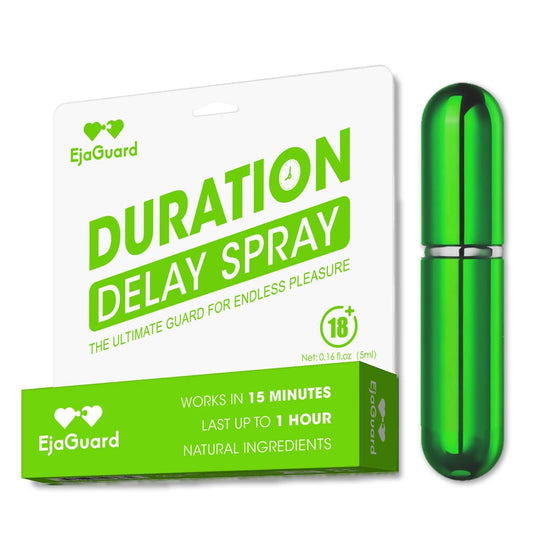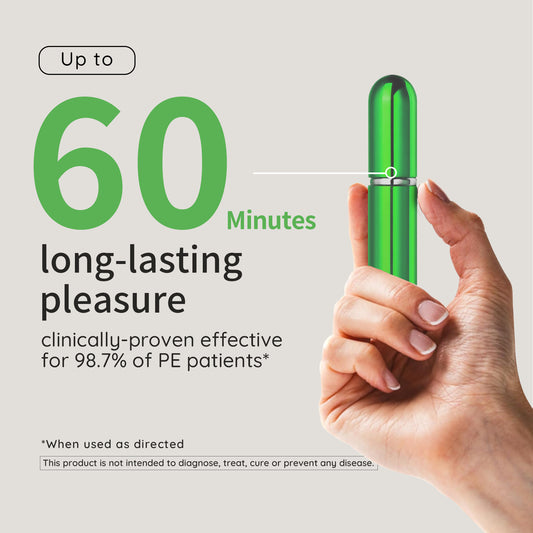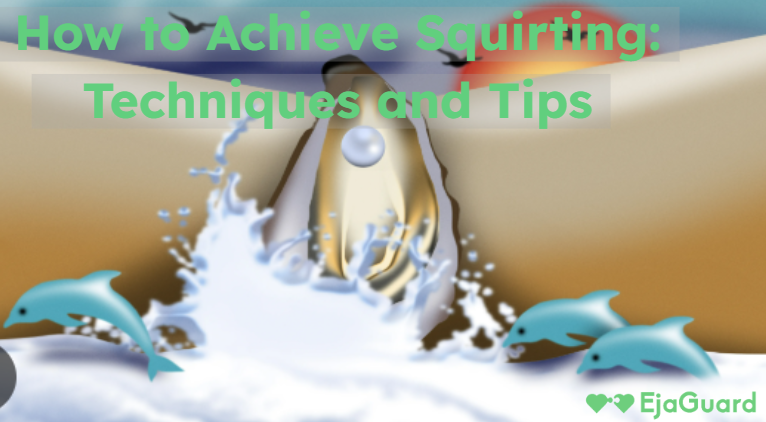Introduction
Squirting is a topic that sparks curiosity and often leaves many wondering about its authenticity and how to achieve it. While there’s plenty of misinformation around this subject, understanding the science behind squirting, how to make yourself squirt, and the physical sensations involved can help debunk myths and improve sexual experiences. For those looking to enhance their pleasure, explore our range of EjaGuard Orgasm Gels for added sensations during sexual activity.

In this article, we’ll explore everything you need to know about squirting, including the role of Skene’s glands, G-spot stimulation, pelvic floor muscles, and much more.
What is Squirting? (Understanding Female Ejaculation)
Squirting is the release of a significant amount of fluid from the female genital area, often during sexual activity. It is closely related to female ejaculation, though many mistakenly use the terms interchangeably. The fluid produced during squirting comes from the Skene’s glands, which are located near the female prostate.
Squirting occurs when the G-spot (a highly sensitive area on the front vaginal wall) is stimulated, resulting in a build-up of fluid that is released during intense arousal. While some people believe that squirting is rare, many women can experience it with the right techniques and pressure. If you're looking for additional tools to help with G-spot stimulation, our EjaGuard Dildos are specifically designed to target this area.

How to Make Yourself Squirt: Techniques & Tips
If you’ve ever wondered how to squirt or how to make yourself squirt, it’s all about mastering the art of G-spot stimulation and applying pressure to the right areas.
Here’s a step-by-step guide on how to make yourself squirt:
-
Find the Right Position: Lying on your back with your legs bent and spread is a great start, but positions like doggy style or woman on top also offer deeper penetration and better access to the G-spot.
-
Use Your Fingers or a Toy: Start with a finger or sex toy specifically designed for G-spot stimulation. Insert the fingers or toy about two to three inches into the vagina and make a "come hither" motion. Enhance your experience with the EjaGuard Masturbators for more satisfying stimulation.
-
Apply Pressure: Gently press on the vaginal wall toward the belly button while maintaining consistent movement. This pressure helps stimulate the Skene’s glands, leading to fluid buildup.
-
Mind the Pelvic Floor: Strengthening your pelvic floor muscles through exercises like Kegels can help enhance your control over the sensations and may increase the chances of squirting.
Keep experimenting with different sex positions to find what works best for your body. The key is relaxation and patience—squirting doesn’t happen on demand, and it requires the right combination of pressure, stimulation, and comfort. You may also find that EjaGuard Lubricants enhance the experience by providing extra smoothness during stimulation.
The Role of Skene's Glands in Squirting
Skene’s glands, often referred to as the female prostate, play a crucial role in squirting. These glands are located on the front wall of the vagina and are responsible for producing the fluid released during squirting.
When stimulated, the Skene's glands can fill with fluid, leading to a strong release during sexual activity. Some people describe the feeling of squirting during sex as both intense and pleasurable, often accompanied by a feeling of relief or release.
Understanding the location and function of these glands can help you better appreciate the mechanics of squirting and how to make the experience even more enjoyable. For more information on how to heighten sexual pleasure, visit our EjaGuard Blog.

Squirting vs. Female Ejaculation: What’s the Difference?
While squirting and female ejaculation share similarities, they are distinct phenomena.
-
Squirting refers to the release of a significant amount of fluid from the Skene’s glands. This fluid is mostly water-based and may appear clear or slightly milky.
-
Female ejaculation, on the other hand, involves the release of a small amount of thicker, more viscous fluid, typically from the urethra. This is often mistaken for urine due to its consistency.
Squirting typically occurs after intense stimulation of the G-spot, whereas female ejaculation can happen with or without G-spot stimulation. Both experiences can lead to enhanced sexual pleasure, but they differ in their fluid composition and the sensations they provoke.
How Squirting Feels: Sensations and Emotional Connection
The squirting feel can vary from person to person, but many describe it as a build-up of pressure within the vaginal wall and pelvic area, followed by a release that feels both intense and freeing.
For some, squirting is accompanied by a wave of pleasure or an orgasmic sensation, while for others, it may simply feel like a release of pent-up sexual tension. Clitoral stimulation during this process can heighten the sensations, making it a more fulfilling and pleasurable experience.
Emotionally, squirting can bring about a deeper connection with a partner, as it requires a high level of trust, comfort, and communication to achieve.
Exploring the Pelvic Floor Muscles and Their Impact on Squirting
Pelvic floor muscles play a critical role in sexual pleasure and the ability to squirt. These muscles surround the vagina and support the bladder, rectum, and uterus. When these muscles are strengthened, they can enhance sexual function, control, and sensitivity.
Strengthening your pelvic floor through Kegel exercises can improve your ability to control the release of fluid during sexual activity. Weakened pelvic floor muscles can make it harder to reach the right level of arousal needed for squirting.
The more you work on strengthening these muscles, the better you can control your sexual experience and potentially increase your chances of achieving squirting. Consider pairing these exercises with EjaGuard Orgasm Gels to further enhance sensation and pleasure.

Best Sex Positions for Squirting and G-Spot Stimulation
Certain sex positions can make it easier to stimulate the G-spot and achieve squirting. Here are some of the best positions to try:
-
Doggy Style: This position provides deep penetration and direct access to the G-spot. Adjusting the angle of your pelvis can help target the right spot.
-
Cowgirl: The woman on top position allows for control over depth and angle, making it easier to hit the G-spot and apply pressure.
-
Spooning: A more intimate position where short strokes can focus on the G-spot, and clitoral stimulation can be added for extra pleasure.
Try experimenting with these positions, or any others that allow for deeper penetration and better control over G-spot stimulation. You may also find that EjaGuard Masturbators help with the precise pressure and angle needed for optimal stimulation.
The Role of Clitoral Stimulation in Achieving Squirting
Clitoral stimulation plays an important role in achieving squirting, as it can amplify the sensations during sexual activity. Many women find that combining G-spot stimulation with clitoral stimulation leads to more intense orgasms and a greater chance of squirting.
Incorporating a vibrating toy, a partner’s fingers, or simply using pelvic movements to create clitoral contact during penetration can make a significant difference. Experiment with different forms of clitoral stimulation to enhance your experience and increase the likelihood of squirting. For a more powerful experience, try out EjaGuard Sex Toys that are designed for maximum pleasure.

Frequently Asked Questions (FAQs)
Q1: What times will squirt happen during sex?
Squirting typically occurs when there is intense G-spot stimulation combined with pressure applied to the vaginal wall. The timing varies based on individual response, but it usually happens after prolonged stimulation and arousal.
Q2: How can I learn how to squirt?
Practicing G-spot stimulation and strengthening your pelvic floor muscles through Kegel exercises can help increase your chances. Try different positions and explore what feels best for your body.
Q3: Is squirting the same as female ejaculation?
While they are often used interchangeably, squirting refers to the release of fluid from the Skene’s glands, whereas female ejaculation involves a small amount of thicker, more viscous fluid released from the urethra.
Q4: Does squirting feel good?
Many women report that squirting feels incredibly pleasurable, often accompanied by intense sensations and emotional connection. It’s a unique experience that enhances sexual pleasure.
Conclusion
Squirting is a natural and pleasurable experience for many women. While it’s not something that happens on demand, understanding the techniques involved—like stimulating the G-spot, applying pressure, and using pelvic floor muscles—can enhance your ability to squirt and increase your sexual satisfaction.
By focusing on sexual pleasure and exploring different sex positions, you can create a more fulfilling sexual experience and improve your chances of squirting. Remember, the journey of discovering squirting is about patience, trust, and communication with your partner. For more insights and tips on enhancing your sexual journey, visit our EjaGuard Blog.
 Buy Now
Buy Now


